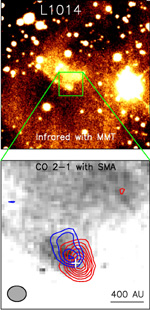 |
|
|
| SMA Research: Low Mass Star Formation | ||||
|
Low-mass stars like our Sun are formed in the dense cores of large
molecular gas clouds. The star formation process is hidden from view
at optical wavelengths due to the large amounts of gas and dust
surrounding the forming star, and even at infrared wavelengths the
most deeply embedded protostars are often difficult to study. Most of
this gas and dust is relatively cool, and observations at
submillimeter wavelengths (a few tenths to one millimeter) are the
best probes of the physical conditions during star formation. Disks
and bipolar outflows are now known to a be a integral part of the
star formation process. Observations of the thermal dust emission and
spectral lines of molecules enable the physics and kinematics of the
large scale envelope and the small-scale disk surrounding the
protostar, and the outflow, to be studied in detail. The magnetic
field geometry can be determined through polarization observations of
charged dust grains. Importantly, interferometer observations allow
most of the emission from the large-scale envelope to be filtered
out, enabling high-resolution studies of the disks and inner
envelopes, where accretion of gas onto the protostar occurs and
where the initial conditions for planet formation are determined.
Such observations are important as they inform us about the
conditions under which our own Solar System and exoplanetary systems
formed. Astronomers are using the SMA to study dense cores before the
onset of star formation and to probe the disks and outflows around
protostars, in cores containing only one new star and in cores
containing small groups.
CfA:
ASIAA:
On-going collaborators:
|

The very compact outflow around the very low luminosity protostar L1014-IRS, as discovered using the SMA. The top panel shows a near-infared imaged obtained with the SAO's MMT (courtesy Tracy Huard). The bottom panel shows a zoomed in section of the infrared image (in greyscale), overlaid with blue and red contours showing high velocity emission from the CO molecule due to outflow gas in a bipolar outflow, one of the key signatures of star formation (Bourke et al. (ADS | astro-ph/0509865 2005 ApJL 633,L129). | |||
|
|
